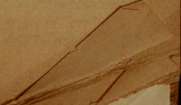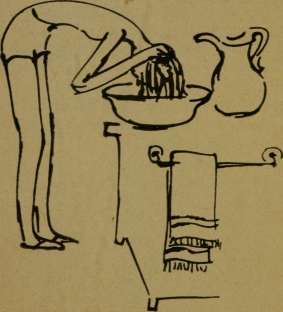
Beautiful hair is about the most important thing a girl has. Whether it be blond, brunette or red, pretty hair can always overcome the handicap of a not-so-pretty face. Unhappily, I must state, the reverse is just as true: unattractive hair can make even the prettiest face seem dull and unattractive. Your hair can make you or break you.
Hair can do all this because hair is what we remember most about a person. How many times have you described a friend as being "that attractive blonde" or that "adorable redhead"? How many times have you observed that the first thing you notice about strangers is the way they wear their hair? How many times have you been astonished to discover that what seems like an overnight metamorphosis in some friend is simply the result of a change of hair-do?
Because hair is so all-important, no teen-ager should ever let herself get down in the dumps about her own crop. No teen-ager should ever exclaim, "But honestly, I can't do a thing with it!" The truth is that you can do everything with it. Hair is the most manageable attribute that you have.
Hair, unlike a nose or a mouth, can be changed. Hair can be grown or cut. Hair can be curled or left uncurled. It can be pinned up in a topknot or turned loose to the four winds. Hair can be almost anything you want it to be.
The reason I insist that hair can do and be all these things is because I know it can. Hair that is well treated is like a talented fashion model—it responds to direction. In one mood it can look casual, in another it can look chic and sophisticated. As you change your moods, you can change your hair to fit. In fact, you do. You rarely wear your hair to a dance the same way you wear it to a beach picnic or a tennis match.
However, there is unfortunately one pitfall in regard to the maneuverability of hair. You really cannot do anything with lifeless hair. Badly kept, dull hair will not respond to direction no matter how long you fuss with it, pin it up, or take it down. For all the good you accomplish in setting it, you might as well have spent the time in a movie. To be manageable (and beautiful), hair must be healthy.
To be healthy, hair must first of all stem from a healthy body. Here again what you eat affects you, for if you are run down or missing on your vitamin quota, your hair will show it. Have you ever noticed how limp the hair of sick people becomes? Their lack of vitality is immediately reflected in their hair. And have you noted, too, that as a sick person regains his or her health, the hair begins to get back its sheen and gloss as well?
Therefore keep constantly in mind the necessity of eating your daily food requirements. Keep up your supply of nutrients and vitamins so that your physical condition is tiptop.
But food alone will not make healthy hair. To be fully healthy, hair must also be clean. Dirty hair not only looks unattractive, it behaves unattractively. It falls in greasy strands and refuses to hold a wave. Further, dirty hair means a dirty scalp, and a dirty scalp means dandruff.
Dandruff is not only a most unpleasant condition to look at; it is also harmful to the hair. It indicates an uncared-for scalp, and one that is not giving the hair roots their proper nourishment. When dandruff scales start to sprinkle your coat collar, it follows that some Jiing is amiss with the scalp.
Dandruff can and ought to be corrected. A bad case of dandruff can cause the skin to break out and wreck an otherwise attractive complexion. Dandruff also can ruin a well-coifed head of hair. Think of the torture it must be for the boy dancing with you, who must look down on a part that lays bare a scaling scalp.

To get rid of dandruff, set yourself a routine. Wash your hair often with a shampoo designed to combat dandruff (ask your druggist to recommend a good one) and brush your hair vigorously, being careful to get the bristles well down into the roots.
Brushing is essential for beautiful hair. Not just lackadaisical brushing, but good stiff get-in-there-and-dig brushing. Brushing stimulates the scalp, encourages good circulation of the blood to the hair roots (which makes for well-nourished hair) and picks up loose dirt that dulls the color of the hair. A good brushing job should leave the scalp feeling tingly.
To be adequately brushed, hair should be stroked at least one hundred times each night. A good rule is to brush until your arm gets tired. Put your head down and start with the brush at the roots of the hair and then follow the hair down to the tips with clean firm strokes.
Combing never replaces brushing. Do not think that because you comb your hair frequently you can get away with a few swipes of the hairbrush. Not for a minute. Combing merely puts the hair in place; it does not give glow and gloss to the hair, as a brush does. You should of course comb your hair in order to keep it well groomed. But combing should be thought of as a finishing touch, not as a basic beauty aid.
There are two important rules to remember about combing and brushing. One is just plain good manners, and that is never to comb or brush your hair in a public place. The second rule is designed to promote hair health: never borrow or lend your comb and brush. Dirty objects can transfer dandruff from one head to another. A broken comb, one with missing teeth, can cause ends to split. Therefore, in view of these hazards, it is far better to keep your own things to yourself and be personally responsible in seeing that they are kept clean and in first-rate condition.
Shampooing your comb and brush is just as important as shampooing your hair. Do both frequently; if anything, shampoo your comb and brush more often than your hair. Dirty combs and brushes applied to clean hair nullify all the good work of a recent shampoo.
When it comes to shampooing your own hair, plan to save at least one night a week for the job. Most teens prefer Thursday night because it puts their hair in shape for the weekend. Some teens may even want to do their hair more often, particularly if it is inclined to be oily. Doing your own hair will save money, so that when you really want a professional beauty parlor job, you will have the cash on hand to pay for it.

In between your beauty parlor trips, you can keep your hair in shape by brushing and shampooing. Shampoo your hair regularly with a good shampoo, one that agrees with your hair—an oily hair needs a drying shampoo, a dry head of hair needs a castile-type shampoo. Do use a good shampoo; do not use an ordinary cake of bath soap. It is almost impossible to make bath soap dissolve completely into lather, and the chances are that it will not rinse out well. A residue will remain on the hair that will dull its shine and make it sticky to the touch. Well-rinsed hair should squeak.
It is not difficult to do a professional shampoo at home. It merely takes a bit of organization. Before you start, make certain that you have all the necessary equipment: shampoo, hot water and a clean towel.
Begin your shampoo by brushing your hair thoroughly. Then tub your head well in water, apply the shampoo, and scrub. Work up a good lather and make sure that it penetrates every square inch. Now rinse out the first lather and start afresh. With the second lathering you should have removed all the dirt. Then rinse your hair three times. With the third rinsing, you should hear the hair squeak as it runs between your fingers.
Next comes a clean towel, which you should use first to wring out the moisture from your hair and then to massage the scalp—thereby soaking up even more hard-to-get-at moisture still clinging to the hair. If possible, brush your hair dry in the sunlight. If not, at least brush it frequently during the drying process.